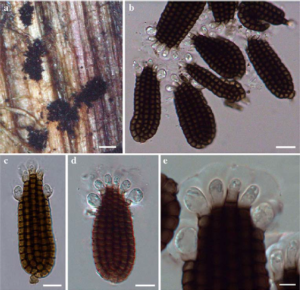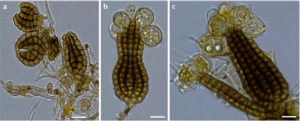Dictyosporium aquaticum Abdel-Aziz.
Index Fungorum number: IF551060, Facesoffungi number: FoF00552; Figs. 1 and 2
Etymology: From the Latin adjective aquaticus, in reference to the freshwater habitat of the fungus.
Holotype: CBS H-21460
Saprobic on submerged wood. Sexual morph Undetermined. Asexual morph Mycelium superficial and immersed in the substrate, sub-hyaline to yellow brown, 2–3μm thick. Sporodochia on natural substratum superficial, circular, subglobose, elongated to irregular, covering most of the wood surface, dark brown to black, ranging diam. Conidia born directly on mycelium or on short lateral, hyaline to yellow brown, one-celled hyphae. Conidia 60–85μm long, 20–30μm wide, excluding appendage (x=69×25μm, n=50), cheiroid when young, become cylindrical or obclavate in frontal view and cylindrical in side view, medium to dark brown, smooth-walled, euseptate, one cell layer thick, cell rows originating from a central basal cell, rows attached along their length, cell rows increase in length from outside to inside, conidial cells are of the same colour and consist of 66 to 82 cells arranged in 5 or 6 rows. Conidial appendages 5 to 6 globose to sub-globose, hyaline appendages that are surrounded by thick gelatinous sheath that spreads in water, each appendage is connected to a row.
Culture characters: Colonies on potato dextrose agar at 25 °C 15–20 mm radius after 15 days, white mycelium with dense yellow reverse, and yellow droplets on mycelium and sporodochia, sporulating after about 3 weeks. Sporodochial and conidial dimensions are similar to those recorded on natural wood.
Material examined: EGYPT, Sohag, River Nile, on submerged decaying date palm, 14 August 2014, F.A. Abdel- Aziz (CBS H-21460, holotype); ex-type living culture, A136. GenBank ITS: KM610236.
Notes: Dictyosporium aquaticum is distinguished from the other species described under the genus by the rounded hyaline appendages attached to the apical cell of each conidial cell row. Based on the key provided by Cai et al. (2003b) and Crous et al. (2009a, b), D. aquatica is morphologically similar to D. bulbosum and D. strelitziae in that the three species have rounded apical appendages. The latter two species, however, have smaller conidia and two apical appendages (Goh et al. 1999; Crous et al. 2009a; b). Phylogenetically, D. aquatica is closest to D. stellatum (conidia 95–140×30–40μm; appendages absent), but has smaller conidia than the latter species.

Fig. 1 Dictyosporium aquaticum (holotype) a Sporodochia on wood b–e Variously shaped conidia with apical hyaline appendages Scale bars: a=150μm, b=20μm, c, d=10μm, e=5μm.

Fig. 2 Dictyosporium aquaticum (ex-type culture) a Young conidia at different stages of development b, c variously shaped conidia with apical
hyaline appendages produced in single spored pure culture. Scale bars: a-c=8μm.
